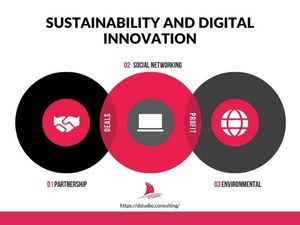The Power of Eco-Friendly Marketing
Green branding has become a powerful force in today’s market.
Consumers are increasingly aware of the environmental impact of their choices and are seeking brands that align with their values. This shift is prompting businesses to adopt eco-friendly marketing strategies.
So, what is the power of eco-friendly marketing?
It not only attracts a loyal customer base but also sets a brand apart in a crowded marketplace. By emphasizing sustainability, companies can build trust and demonstrate responsibility, leading to stronger customer relationships and increased brand loyalty.

Moreover, eco-friendly marketing can result in long-term cost savings through efficient resource use and waste reduction. It helps companies comply with environmental regulations and improves their public image, making them more appealing to investors and partners. Ultimately, green branding is a win-win, benefiting both the planet and the business.
The evolution of green branding
Green branding has come a long way from its early days when only a handful of companies considered environmental impact in their branding strategies. Initially, it was niche and often seen as a luxury or a unique selling point for only a few forward-thinking brands.
Over time, as awareness of environmental issues grew, so did the demand for sustainable practices.
Today, green branding is no longer just an option – it’s a necessity. Companies are integrating sustainability into every aspect of their operations, from sourcing materials to production and packaging.
Current trends show a significant shift towards transparency, with brands openly sharing their eco-friendly practices and the origins of their products. Innovations in sustainable technology and renewable energy are also driving this movement forward.
Looking ahead, green branding is set to become even more integral to marketing. With consumers increasingly prioritizing sustainability, brands that fail to adapt may find themselves left behind. The future of marketing is green, and those who embrace it are likely to thrive.
Components of Green Branding
Green branding is built on several key components that collectively drive sustainability and enhance brand value.
- Sustainable Products At the forefront are sustainable products. These are crafted from eco-friendly materials and manufactured using practices that minimize environmental impact. By prioritizing renewable resources and reducing waste, companies create products that appeal to environmentally conscious consumers, strengthening brand loyalty.
- Eco-Friendly Packaging: Eco-friendly packaging is another crucial element of green branding. Reducing waste through innovative, sustainable packaging solutions not only cuts down on pollution but also enhances a brand’s green credentials. Packaging made from recycled or biodegradable materials showcases a company’s commitment to environmental responsibility and resonates with consumers seeking to reduce their carbon footprint, thereby improving brand perception.
- Green Certifications and Labels: Lastly, green certifications and labels like LEED, Energy Star, and Fair Trade play a significant role in green branding. These certifications provide credibility and assure customers that a company meets high environmental standards. They help differentiate truly sustainable brands from those merely claiming to be green, enhancing trust and boosting brand reputation. By incorporating these elements, companies can build a strong, trustworthy green brand that stands out in the marketplace.

By integrating sustainable products, eco-friendly packaging, and credible certifications into their marketing strategies, companies can effectively position themselves as leaders in sustainability, driving both brand growth and positive environmental impact.
Join the movement towards a greener future—reach out to us to start your green branding journey.
Strategies for Effective Green Branding
Effective green branding hinges on a few key strategies that resonate with today’s environmentally conscious consumers. One of the most powerful tools is brand storytelling.
Crafting a compelling narrative around a brand’s commitment to sustainability can captivate audiences and create a deep emotional connection. This story should highlight the brand’s journey, its values, and its genuine efforts to make a positive environmental impact.
Transparent communication is equally crucial. Honesty and openness about green practices build trust and credibility. Consumers are increasingly skeptical of vague or exaggerated claims, so being clear about what the brand is doing right and where it can improve is essential. This transparency not only enhances brand integrity but also fosters a loyal customer base.
Lastly, consumer education plays a vital role. Engaging and educating consumers about the benefits of choosing green products can drive informed purchasing decisions. Providing clear information on how sustainable choices make a difference helps consumers feel empowered and reinforces their decision to support a green brand.
Bumps in the road in Green Branding
Green branding, while powerful, comes with its own set of challenges. One major issue is greenwashing, where brands misleadingly market products as environmentally friendly.
This not only damages consumer trust but also tarnishes the brand’s reputation when the truth comes to light.
Another significant challenge is the cost implications. Implementing sustainable practices often requires substantial investment in new technologies, materials, and processes.
These expenses can be daunting for businesses, particularly smaller ones, striving to balance sustainability with profitability.
Lastly, market perception poses a hurdle. Consumers are increasingly skeptical, and building trust with eco-conscious buyers demands genuine commitment and transparency.
Brands must consistently prove their dedication to sustainability through clear actions and honest communication to overcome this skepticism and establish a loyal customer base. Balancing these challenges is crucial for brands aiming to make a genuine impact and succeed in the green market.

The future is most certainly green
The future of green branding is bright and transformative. Innovative practices are on the horizon, with emerging technologies like biodegradable materials, renewable energy solutions, and zero-waste manufacturing set to revolutionize the field. These advancements promise to make sustainability more accessible and effective for brands across all industries.
Consumer trends are also shaping the future of green branding. As awareness of environmental issues grows, consumers are demanding more from the brands they support. They seek transparency, ethical practices, and genuine sustainability efforts. Brands that can meet these expectations will not only thrive but lead the market.
On a global scale, green branding will play a crucial role in addressing environmental challenges. By promoting sustainable practices and encouraging responsible consumption, green brands can help mitigate climate change, reduce waste, and conserve resources.
The collective impact of these efforts will contribute significantly to a healthier planet, making green branding a vital component of future business strategies.
Conclusion
In conclusion, the future of green branding holds immense potential for both businesses and the planet. As innovative practices and emerging technologies like biodegradable materials, renewable energy solutions, and zero-waste manufacturing gain traction, sustainability will become increasingly accessible and integral to brand strategies.
These advancements will not only enhance environmental efforts but also drive business success by aligning with the growing consumer demand for transparency, ethical practices, and genuine sustainability.
Consumer trends indicate that brands committed to these values will not only meet market expectations but also lead the industry. By adopting and promoting sustainable practices, businesses can build trust and loyalty, setting themselves apart in a competitive landscape.
On a global scale, green branding will be pivotal in addressing pressing environmental challenges, helping to mitigate climate change, reduce waste, and conserve resources.
Ready to transform your brand with sustainable practices? Let us help you navigate the future of green branding.










